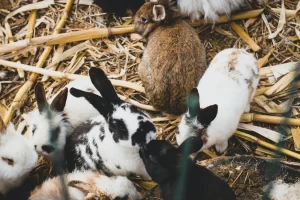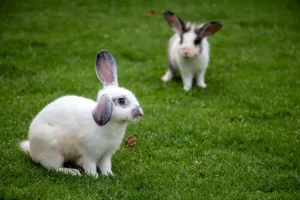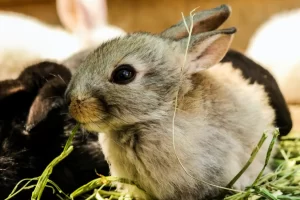Have you ever wondered how to determine the age of a rabbit? Like a detective examining clues, you can unravel the mysteries of their age through physical indicators, dental examination, and behavioral cues.
By understanding their growth stages and size, you’ll gain insight into their journey through life. Other factors, such as medical history and diet, also play a role in estimating their age.
Join us as we explore the fascinating world of rabbit age determination and unlock the secrets hidden within their furry little bodies.
In This Article
- 1 Key Takeaways
- 2 Physical Indicators of Age
- 3 Dental Examination for Age Determination
- 4 Behavioral Clues to Assess Rabbit’s Age
- 5 Growth Stages and Size as Age Indicators
- 6 Other Factors That Help Determine Rabbit’s Age
- 7 Frequently Asked Questions
- 7.1 What Are the Common Health Issues That Can Affect a Rabbit’s Physical Appearance and Make It Difficult to Determine Its Age Based on Physical Indicators?
- 7.2 Are There Any Specific Dental Problems That Can Cause a Rabbit to Appear Older or Younger Than Its Actual Age?
- 7.3 Can a Rabbit’s Behavior Change as It Ages, and Are There Any Behavioral Indicators That Can Help Determine Its Age?
- 7.4 What Are the Factors That Can Affect the Growth and Size of a Rabbit, Making It Challenging to Accurately Assess Its Age Based on These Indicators?
- 7.5 Are There Any External Factors, Such as Diet or Environment, That Can Influence a Rabbit’s Physical Appearance and Make It Harder to Determine Its Age Using Traditional Methods?
- 8 Conclusion
Key Takeaways
- Physical indicators such as fur color, mobility changes, and body condition scoring can help determine a rabbit’s age, but they have limitations and should be considered alongside other methods.
- Dental examination, including dental wear and gum coloration, is a reliable indicator of a rabbit’s age, but professional evaluation is important to ensure accuracy.
- Behavioral clues, such as feeding and grooming behavior, social interactions, and eating habits, can provide insights into a rabbit’s age, but should be combined with other methods for accuracy.
- Growth stages, size, and weight changes can be used as age indicators, but it is essential to consider dental examination and body condition scoring, and consult a veterinarian for a professional evaluation.
Physical Indicators of Age
You can often determine a rabbit’s age by looking at its physical indicators. One important factor to consider is the differences in fur color. Young rabbits tend to have softer, lighter-colored fur, while older rabbits may have coarser, darker-colored fur.
Another indicator is changes in mobility. As rabbits age, they may experience a decrease in their mobility due to joint stiffness or arthritis. They may also develop a hunched posture or have difficulty hopping and running.
Additionally, dental examination can provide valuable insight into a rabbit’s age. Young rabbits have sharp, white incisors, while older rabbits may have worn down or discolored teeth.
Body condition scoring is another method used to estimate a rabbit’s age. By evaluating the amount of fat and muscle on their body, you can get an idea of their overall health and age.
However, it’s important to note that these methods have their limitations, and for a more accurate assessment, it’s recommended to consult a veterinarian who specializes in small animal medicine.
Dental Examination for Age Determination
Take your rabbit to the veterinarian for a dental examination to accurately determine its age. This is because dental wear is a reliable indicator of a rabbit’s age.
A veterinary specialist or rabbit expert would be knowledgeable about the different factors that can be used to estimate a rabbit’s age through dental examination. They’d explain that as rabbits age, their teeth undergo changes such as wear and tear, which can help determine their approximate age. Additionally, gum coloration can also provide some insight into a rabbit’s age.
However, it’s important to note that these methods have their limitations and may not provide an exact age. Therefore, it’s recommended to consult a veterinarian for a more accurate assessment.
Behavioral Clues to Assess Rabbit’s Age
Observe your rabbit’s behavior during feeding and grooming to get clues about its age. Social interactions and eating habits are two important factors to consider when assessing a rabbit’s age.
Young rabbits, typically less than one year old, are usually more active and playful, engaging in frequent social interactions with other rabbits or their owners. They also have a voracious appetite and consume food eagerly.
As rabbits age, their social interactions may decrease, and they may become more independent and solitary. Older rabbits may also exhibit changes in their eating habits, such as a decrease in appetite or difficulty chewing due to dental issues.
It’s important to note that these behavioral clues aren’t definitive indicators of age and should be considered alongside other methods, such as dental examination and body condition scoring, for a more accurate assessment.
If you have concerns about your rabbit’s age, consult a veterinarian for a thorough evaluation.
Growth Stages and Size as Age Indicators
Can you determine the age of a rabbit by looking at its growth stages and size?
As a veterinary specialist in small animal medicine, I can provide you with accurate and detailed information on how to estimate a rabbit’s age using these factors.
Weight changes throughout a rabbit’s lifespan can give us valuable clues. Young rabbits tend to gain weight rapidly, while older rabbits may experience weight loss due to age-related conditions.
Additionally, hormonal changes and reproductive maturity in rabbits can also indicate age. Female rabbits typically reach sexual maturity around 4 to 6 months of age, while males may show signs of maturity as early as 3 months.
However, it’s important to note that these methods have their limitations, and a more accurate assessment can be made through dental examination, body condition scoring, and the presence of certain physical markers.
If you’re unsure about your rabbit’s age, it’s always best to consult a veterinarian for a professional evaluation.
Other Factors That Help Determine Rabbit’s Age
You should consider both weight changes and reproductive maturity when determining a rabbit’s age. Age estimation in rabbits can be challenging, but there are several factors that can help you get an idea of their age. Here are some key points to consider:
- Weight Changes: A rabbit’s weight can provide clues about their age. Young rabbits tend to gain weight rapidly, while older rabbits may experience weight loss due to the natural aging process or underlying health issues.
- Reproductive Maturity: The age at which a rabbit reaches reproductive maturity can vary among breeds. Generally, rabbits reach sexual maturity around 4 to 6 months of age. Examining the development of the reproductive organs can give you an indication of their age.
- Environmental Influences: The environment in which a rabbit was raised can also impact their growth and development. Factors like nutrition, housing conditions, and overall care can influence their physical appearance and provide additional insights into their age.
Frequently Asked Questions
What Are the Common Health Issues That Can Affect a Rabbit’s Physical Appearance and Make It Difficult to Determine Its Age Based on Physical Indicators?
Common health issues, such as diseases and nutrition, can affect a rabbit’s physical appearance, making it difficult to determine its age based on physical indicators. It is important to consider these factors when estimating a rabbit’s age.
Are There Any Specific Dental Problems That Can Cause a Rabbit to Appear Older or Younger Than Its Actual Age?
Dental problems can affect a rabbit’s appearance, making it difficult to determine its age. Issues like overgrown teeth or missing teeth can make a rabbit look older or younger than it actually is.
Can a Rabbit’s Behavior Change as It Ages, and Are There Any Behavioral Indicators That Can Help Determine Its Age?
As a rabbit ages, its behavior can change. Certain behavioral indicators can help determine its age. Understanding the rabbit aging process and the relationship between age and behavior is key to accurately assessing its age.
What Are the Factors That Can Affect the Growth and Size of a Rabbit, Making It Challenging to Accurately Assess Its Age Based on These Indicators?
Factors such as growth and size can affect the accuracy of assessing a rabbit’s age based on behavioral indicators. It can be challenging to determine age without considering these factors.
Are There Any External Factors, Such as Diet or Environment, That Can Influence a Rabbit’s Physical Appearance and Make It Harder to Determine Its Age Using Traditional Methods?
Dietary impact and environmental influence can affect a rabbit’s physical appearance, making it challenging to determine its age using traditional methods. Factors like nutrition and habitat play a role in assessing a rabbit’s age accurately.
Conclusion
In conclusion, determining a rabbit’s age can be challenging but there are several methods that can help.
Physical indicators such as fur color and texture, as well as the presence of certain physical markers, can provide clues to their age.
Dental examination is also a reliable method, as the growth and wear of their teeth can indicate their age.
Additionally, observing their behavior and growth stages can offer insights.
Consulting a veterinarian is recommended for a more accurate assessment.





